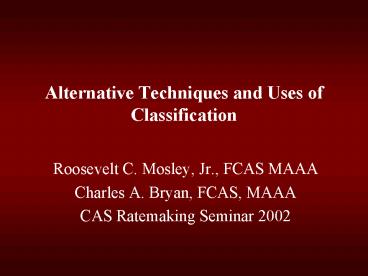Alternative Techniques and Uses of Classification - PowerPoint PPT Presentation
1 / 29
Title:
Alternative Techniques and Uses of Classification
Description:
Alternative Techniques and Uses of Classification. Roosevelt C. Mosley, Jr., FCAS MAAA ... Classification and Regression Trees (CART) All are multivariate techniques! ... – PowerPoint PPT presentation
Number of Views:58
Avg rating:3.0/5.0
Title: Alternative Techniques and Uses of Classification
1
Alternative Techniques and Uses of Classification
- Roosevelt C. Mosley, Jr., FCAS MAAA
- Charles A. Bryan, FCAS, MAAA
- CAS Ratemaking Seminar 2002
2
Discussion Topics
- Classifications Methods
- New and alternative applications of
classification methods - Examples of applications of classification methods
3
Principles of Sound Risk Classification System
- Reflect cost and experience differences on the
basis of relevant risk characteristics - Applied objectively and consistently
- Practical, cost-effective, and responsive to
change - Minimize anti-selection
4
Reflect cost and experience differences based on
relevant risk characteristics
- How do we determine which risk characteristics
are important? - How do we reflect the cost and experience
differences between these risks?
5
Historically speaking
- Relevant risk characteristics
- Historical experience
- Intuition
- Reflecting cost differences
- One way analysis (loss ratio, pure premium)
- Multi-way tables
- Mini multi-variate analysis
6
Where we are today (for the most part)
- Relevant risk characteristics
- Historical experience
- Intuition
- Reflecting cost differences
- One way analysis (loss ratio, pure premium)
- Multi-way tables
- Mini multi-variate analysis
7
Some companies are using new techniques
- Generalized Linear Models (GLMs)
- Chi-square Automatic Interaction Detector (CHAID)
- Classification and Regression Trees (CART)
All are multivariate techniques!
8
Why use multivariate analysis?
- Traditional Actuarial ApproachAnalyze each
rating factor independent of all the other
factors (one way analysis) - Inherent Assumption Mix of business underlying
the levels of each factor are the same - Result Double counting of factor impacts
- Multivariate AnalysisAnalyze each factor
simultaneously, thus removing the distributional
bias
9
One Way Analysis
10
Multi-variate analysis
11
Multivariate analysis
12
Simple Regression
- y a bx error
Response Variable
Explanatory Variable
y a bx cz dw error
13
GLM
- y h(X?) error
- Exponential family of distributions
- Normal
- Poisson
- Gamma
- Binomial
14
Examples
- Frequency Model
- y exp(X?) error, y Poisson
- Severity Model
- y exp(X?) error, y Gamma
- Retention Model
- y 1 / (1 exp(- X?)) error, y Binomial
15
Generalised Linear Models
- LINEAR MODELS GLM
- µ X? µ h(X?)
- Inverse of
h, g, is called the - link function
- Variance independent Variance function
- of the mean of the mean
- Randomness is Normal Randomness is
Exponential Family (Normal, Poisson,
Gamma, Binomial)
16
CHAID Analysis
- Process used to analyze a dependednt variable
- Subdivides population of risks based on subsets
of independent variable characteristics - Goal partition data into mutually exclusive,
exhaustive subsets - Does not address rate relativities associated
with the final categories
17
CHAID Analysis An Example
18
Examples of Uses of Classification Techniques
- Roosevelt C. Mosley, FCAS, MAAA
- MHL / Paratus
- 2002 CAS Ratemaking Seminar
19
Examples of Applications
- Pricing application of renewal modeling
- Flexible multi-factor underwriting model
20
Renewal Modeling
- Background
- Regional non-standard insurer
- Significant indicated rate need
- Historical retention in the mid 60s
- Question
- If we take the indicated rate need, what will
that do to the ability to retain business?
21
Approach
- GLM analysis of frequency and severity
- Included factors currently rated on
- Renewal analysis
- Included factors from GLM analysis, plus
- Competitive index
- Renewal premium
22
Class Renewal Likelihood
23
Competitive Position
24
Demand for Renewal
25
Renewal Impact on Projected Loss Ratios
26
Application Flexible Underwriting Plan
One Strike and Youre Out Approach
27
More Equitable Approach
0-1 Not at Faults
2 Not at Faults
Etc...
28
More Flexible, Equitable Approach
Factor 1
Factor 2
Factor N
The more factors you include, the more important
a multi- variate analysis becomes!
29
Conclusion
- Many other applications are possible
- New approaches have implications for areas other
than pricing and underwriting - Maximizing the benefit of the enormous
information available































